The Victor-Victrola Page
Determining the Condition and Market Value of a
Phonograph
This is a complicated
and lengthy subject and not all collectors will agree with these perspectives.
Based on years of restoring machines and providing appraisals, this is
a summary of the assessment process we use to determine the condition and value of phonographs. Some machines can be extremely
difficult to appraise due to a variety of subtle issues, and can prove to be challenging for
the best experts in the field. However, in most
instances, new collectors can make a reasonably informed decision about the
"condition and market value" of their phonograph if they are follow these guidelines
and are willing to do some online research.
This discussion is focused on properly evaluating a machine to determine what a serious and
knowledgeable buyer will actually pay for a Victor product in the current market.
We are not attempting to belittle any phonograph or collection, or
to insult the owner of a business which sells phonographs. Many owners and
collectors treasure their machines regardless of condition, and the fact
that a phonograph is imperfect or has been marginally restored does not in
any way detract from the enjoyment of the hobby.
For those
readers who are simply interested in a accurate condition-ranking and appraisal of
their phonograph without spending a lot of time on the 'hows and whys' of
the appraisal process, we offer a comprehensive (paid) appraisal service, which
can be found here.
These guidelines can be applied to virtually
any brand of antique phonograph; however our focus is on those products made
by the Victor Talking Machine Company between 1901 and 1929.
This topic is split into two major sections:
-
PART ONE: Assessing and grading the true condition of a phonograph
-
PART TWO: Making a comparison-based estimate of value
PART ONE:
Assessing and grading the condition of a phonograph
The condition of a phonograph must be accurately determined before any estimates of
value are undertaken. In the field of antiques, condition is a critical
factor, and the valuation will usually rise exponentially as the condition
of the item approaches 'brand new'. Some variation in
the assessment of condition is to be expected; this can be true even amongst the
most experienced
appraisers. Significant disagreements exist within the collector and
investor community on the value of certain phonographs, often due to
variances in their personal experiences and subjective viewpoints.
However, with some research work, most readers should be able to derive an acceptable estimate of a phonograph's condition-ranking and approximate market value.
As a quick summary for determining the condition of an antique machine:
A. The appraiser must first determine if the machine is correct, meaning that it has authentic mechanics, hardware components and cabinet parts that would have been installed by the factory when it was new (e.g. has it been altered or updated?)
B. Then the appraiser must make a determination if the phonograph is in original condition, or if it has been wholly or partially restored.
C. If it has been restored, then the quality of the restoration must be determined via grading the machine on a "three-tier" basis
D. If the machine has an original finish, the appraiser will make a
judgmental comparison
between an imaginary machine which is "brand new" and the one
being evaluated. From there, a "six-tier" rating scale can be applied to
classify the graded condition
The vast majority of readers who submit information or questions to our website consider their antique phonograph to be in "excellent" or "mint" original condition. Unfortunately, from an appraisal standpoint, far less than 5% of the surviving phonograph population would fall into these two categories (combined). See discussion below.
A. DETERMINING IF A MACHINE HAS THE CORRECT
CONFIGURATION
The appraiser must first
determine if the phonograph has the correct
hardware, mechanics and cabinet components. This process includes a careful
inspection of trim parts, knobs, motor type, controls, etc. Performing this
type of evaluation requires a comprehensive knowledge of the proper layout, components and configuration
of the model being assessed; much of the necessary information can be found
under the
Layout and
Product Information pages of this
website. Parts which are missing or incorrect will require noting on the
appraisal, and a corresponding adjustment to the valuation will be made to include replacement costs for these parts.
Phonographs were often 'updated'.
This may include the installation of newer turntable systems and/or the
addition of electronic components. The appraiser must be certain that the
mechanisms and internal components are correct for the model and time period
when it was manufactured.
The appraiser must also be familiar with the
many different types of veneers and finishes that Victor produced over the
years. The evaluation would also
include the type of plating used on the hardware parts. This discussion is
continued below.
B. IDENTIFYING AN ORIGINAL OR
RESTORED FINISH
We define the term "Restoration" as the process of
modifying or replacing the original finish and/or cosmetics of a phonograph.
This could include stripping the original finish and applying new finish
materials, or
simply using solvents or softeners to wipe-down the original finish in order
to smooth-out or remove blemishes. It could also include the use of
'overspray' materials which cover the original factory finish to increase
the 'gloss'. Such restoration work may involve the entire machine, or only
portions of the cabinet. In all these examples, the original finish has been modified, and this
constitutes a "Restoration" by our standards.
"Restoration" does NOT include making necessary repairs to
the mechanical components. Mechanical work to assure correct
functionality should never give cause to classify a phonograph as 'restored'
as long as the repairs are made correctly, using original-type
replacement parts. In most instances, making repairs on spring-wound phonograph motors or
other components is not a costly endeavor. An exception would be for 1920's
machines with electronic amplification and/or radios. Repairs to these
electronic systems can become quite costly; however once complete, the
appraised value would increase correspondingly.
To begin an assessment, the appraiser must be
familiar with how the appraised machine appeared when new. Most Victors
and Victrolas made between 1901 and 1924 used a varnish-over-shellac finish,
but there are exceptions to this rule. Some oak finishes have a
shellac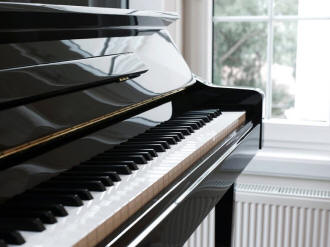 finish with a protective wax applied; others may have been fumed via an
ammonia bath and will have no finish coats. Those machines with a
varnished finish were certainly smooth and glossy, but never to the extent one
would find on a lacquered, mirror-finish piano today (as
seen at right). Victrolas produced after 1925, featured
a semi-gloss lacquer finish, which has a very muted appearance with
only slight reflectivity. Bear in mind that the vast majority of
Victor products were mass-produced. While there were a few special-order models
with fine hand-crafted finishes, over 99% of Victor's phonographs came down
the assembly line quickly, were dumped in a stain tank and then
either brushed or sprayed by hand with finish coats. Then a quick polish and
out the door it went. Victor's quality control was excellent; it is
extremely rare to find an original machine with drips or runs, or showing
signs of dust or contamination in the finish. So while Victor's products always
featured an excellent appearance, they must be considered as production-line
products and will not replicate the craftsmanship one would find in
expensive world-class furniture. In order to determine true
condition, the appraised machine must be subjectively evaluated against how it appeared
when new. It is therefore imperative that the appraiser understand the
degree of glossiness and surface texture which were found on the different
finishes when the machine was produced. There is often some degree of
overlap in shading and finish texture in each finish type due to nominal
variations of the veneers which were used, but for example, the appraiser
should expect Victor's "GOP" (Golden Oak Polished) finish to be much more
reflective/glossy than the "GOW" (Golden Oak Waxed) finish. To further complicate matters, there
can also be considerable overlap
between some of Victor's more expensive finishes such as American Walnut and
Circassian Walnut; some Victrolas will exhibit grain figuring and staining
characteristics that are common to both varieties. This can cause confusion
and disagreement in the appraisal process. A complete discussion of the
types of finishes appears here,
and readers are encouraged to review this subject before proceeding further.
finish with a protective wax applied; others may have been fumed via an
ammonia bath and will have no finish coats. Those machines with a
varnished finish were certainly smooth and glossy, but never to the extent one
would find on a lacquered, mirror-finish piano today (as
seen at right). Victrolas produced after 1925, featured
a semi-gloss lacquer finish, which has a very muted appearance with
only slight reflectivity. Bear in mind that the vast majority of
Victor products were mass-produced. While there were a few special-order models
with fine hand-crafted finishes, over 99% of Victor's phonographs came down
the assembly line quickly, were dumped in a stain tank and then
either brushed or sprayed by hand with finish coats. Then a quick polish and
out the door it went. Victor's quality control was excellent; it is
extremely rare to find an original machine with drips or runs, or showing
signs of dust or contamination in the finish. So while Victor's products always
featured an excellent appearance, they must be considered as production-line
products and will not replicate the craftsmanship one would find in
expensive world-class furniture. In order to determine true
condition, the appraised machine must be subjectively evaluated against how it appeared
when new. It is therefore imperative that the appraiser understand the
degree of glossiness and surface texture which were found on the different
finishes when the machine was produced. There is often some degree of
overlap in shading and finish texture in each finish type due to nominal
variations of the veneers which were used, but for example, the appraiser
should expect Victor's "GOP" (Golden Oak Polished) finish to be much more
reflective/glossy than the "GOW" (Golden Oak Waxed) finish. To further complicate matters, there
can also be considerable overlap
between some of Victor's more expensive finishes such as American Walnut and
Circassian Walnut; some Victrolas will exhibit grain figuring and staining
characteristics that are common to both varieties. This can cause confusion
and disagreement in the appraisal process. A complete discussion of the
types of finishes appears here,
and readers are encouraged to review this subject before proceeding further.
The first step in evaluating any antique is to
determine if it has been restored or if it retains its original finish.
In most instances, a phonograph which has been restored will be worth less than an
identical phonograph which retains its original finish, even if the original
finish shows signs of wear. This topic will be discussed in
detail in the "Valuation" section. A machine which has been restored, even
by the most proficient experts, will usually exhibit a few clues of the
restoration work which will become apparrent to an experienced appraiser;
however these small imperfections can be easily overlooked by the average
collector. It may be necessary to remove cabinet components to inspect
hidden areas for evidence of rework or newly applied finish materials. For
exceptionally well-executed restorations, a "UV" lamp may be required to
search for variations in finish depth and/or evidence of recent rework. This
type of inspection goes beyond the scope of this discussion. We have noted
several instances where the restoration work was so well executed that it
became very difficult to determine if the machine was a mint-original or a
world-class restoration. One major collector recently purchased a beautiful
"mint-original" machine at auction, only to find that it had been
exceptionally well restored when later inspected in direct sunlight. The
only clues were some tiny overspray ''specs" under
the motorboard and inside the cabinet which would never have appeared on an
original factory finish. It was a superb restoration; however the buyer was
still disappointed
that he had not purchased an original machine.
However, these situations are quite unusual. In most cases, it
is very easy to determine if a machine has been restored. The vast majority
of 'restored' machines one will find for sale on Ebay or at the local
auction house have been restored incorrectly. There
are only two types of restorations: correct and incorrect. There is no such thing as an 'almost correct'
restoration when evaluating a machine for an appraisal. Many
readers will find a Victrola in their attic, and claim that "Aunt Tilly
bought it brand new and it has never been touched". After a brief
evaluation, it is very apparent that 'Uncle Fred' must have restored it in
his basement many years ago, and that level of restoration is virtually
always incorrect. The valuation will consequently become a big disappointment.
So
what constitutes a correct restoration? It is the process of replicating
(to the extent possible) the original appearance of the entire phonograph,
right down to matching the wood color (shading), the use of proper grain fillers, and
achieving the
correct degree of glossiness. This requires a significant effort in
copying the finishing processes and materials that were used when the machine was
originally manufactured. An authentic restoration is extremely
time-consuming and can be very costly. Mastering the process of properly
preparing and stripping the finish, repairing damage, using
the proper types of stain to match the original, correctly applying
authentic base sealers and finish coats, and attention to details
such as accurately replating the hardware is not a trivial task. The staff
at "Joe's Furniture Restoration" service will certainly not have this
skillset. Stripping off the old finish via washing-down the cabinet in a
tank, using a low-cost commercial stain and slapping on a
coat of polyurethane may be great for an old kitchen table, but will not
result in an authentic restoration for an antique phonograph.
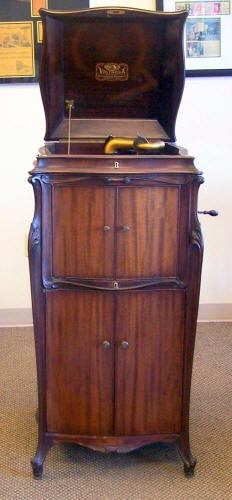 Unless
the restorer locates the
proper finishing materials and has experience in the application methods, it
is highly unlikely that the end-result will be considered 'correct' in the
eyes of a serious collector. Modern finishing materials that one may find at
ACE Hardware or Home Depot usually have some form of '"poly" or "thane" in their names (e.g.
polyurethane, urethane, varathane, etc.) which implies a plastic-based
substance is present in the material. This is done to reduce VOC's, meaning
that the products are not as dangerous or polluting as were earlier generations of
finishing materials. Plasticized finish products will not provide the same appearance as did the original varnishes or shellacs that were
used when the machines were new. So, given the difficulties in finding
authentic finishing materials today (they are still available from limited
sources), and developing the necessary skills to apply them correctly, it
follows that not many restorers will be capable of
executing an accurate restoration. A restored machine may have a beautiful
and stunning appearance, and yet be completely ruined from a collector's standpoint because the restoration is
incorrect.
This is the single most common problem we find today, and will severely
decrease the appraised value of a phonograph. A
detailed summary of a proper restoration process can be found
here.
Unless
the restorer locates the
proper finishing materials and has experience in the application methods, it
is highly unlikely that the end-result will be considered 'correct' in the
eyes of a serious collector. Modern finishing materials that one may find at
ACE Hardware or Home Depot usually have some form of '"poly" or "thane" in their names (e.g.
polyurethane, urethane, varathane, etc.) which implies a plastic-based
substance is present in the material. This is done to reduce VOC's, meaning
that the products are not as dangerous or polluting as were earlier generations of
finishing materials. Plasticized finish products will not provide the same appearance as did the original varnishes or shellacs that were
used when the machines were new. So, given the difficulties in finding
authentic finishing materials today (they are still available from limited
sources), and developing the necessary skills to apply them correctly, it
follows that not many restorers will be capable of
executing an accurate restoration. A restored machine may have a beautiful
and stunning appearance, and yet be completely ruined from a collector's standpoint because the restoration is
incorrect.
This is the single most common problem we find today, and will severely
decrease the appraised value of a phonograph. A
detailed summary of a proper restoration process can be found
here.
So how do we determine a 'correct restoration'? Let's start with a basic
example; the relatively rare and
low-production VV-125 shown at left. It has a very impressive
appearance, and shows beautiful wood grain; has no runs or drips in the finish,
and the Victrola works well. But it is a terrible
restoration. This machine was originally produced with a very glossy dark red-brown
stain (as seen under the lid) with the same high-luster surface finish on
all surfaces, inside and out.
After the restoration, it now has a 'two-tone' appearance, with the front doors not matching the
rest of the cabinet.
It has been refinished improperly, and is considered to be an "incorrect restoration".
The valuation will suffer significantly.
So why would somebody perform
this type of restoration on a rare machine? There are many reasons. It might
have been in rough condition and looked too tired to put in the living room.
Or perhaps someone
just wanted a 'jazzy' looking antique. Maybe it was restored 60 years ago,
at a time when these old phonographs were considered to be worthless. Most
likely, the restorer had no idea how to replicate the original colors and
finish, and probably didn't care at the time. As an example, my dad
'restored' virtually all the hand-me-down antiques that he brought home from
his parent's house, and most of the rework consisted of bright stain colors
and polyurethane finish coats. Regardless of the reason, it will be very
difficult to get any serious money for something that has been improperly
restored today, as the
dedicated
collector (who has the cash to spend on rare phonographs) would have to re-restore it in order
to make it acceptable in a high-end collection. Better to purchase an
excellent original example.
The VV-XVI machine (picture at right) also has clear signs of an "incorrect restoration". Note that the shading
on the flat panel under the lid (where the decal is located) is darker
and slightly glossier than the corners, also seen when compared to the motorboard and exterior. That type of difference
could be due to
prolonged exposure to heat in an attic, where the interior areas were
better protected. This type of exterior fading occurs frequently on many original
machines as seen on the original VV-IX (picture below right). But in the case of the
restored XVI, wouldn't the motorboard (the area around the turntable) also have
been preserved and still retain the original darker color and gloss? Why are
the protected areas different in shading? And if the cabinet had
faded due to exposure, the exterior should be a bit rough and
crazed, or show damage from being knocked-around in an attic for 100 years?
Nope, those exterior surfaces are smooth as silk, just with a slightly
different color and glossiness than the area under the lid. Therefore, this
is also an "incorrect restoration", and the machine will frankly is not be worth much in today's market.
The
VV-IX (picture lower right) is an original finish, with typical aging effects on the
cabinet's exterior. You can see that the entire inside area retains
the same color and luster, and that the exterior certainly shows consistent signs of wear and aging.
It's all a matter of doing good detective work.
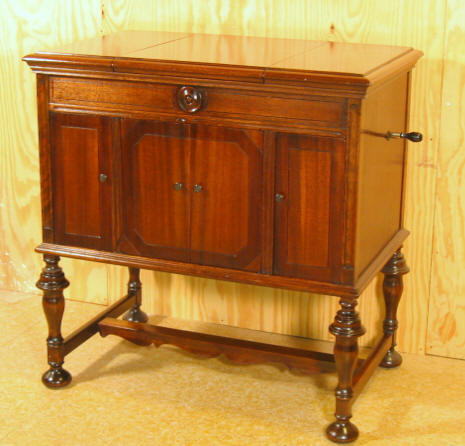 Many
readers submit pictures of phonographs which they sincerely believe to be
original, when it is obvious that a restoration was performed, possibly many
years ago. If a previous owner restored the machine back in 1960, the finish
may appear to be old. Since that time, the phonograph might have been stored in damp locations, or may have
been knocked-around a bit; so that 60 year-old restoration may now look like an
'original finish'. The appraiser must always look carefully for the
'tell-tale' signs of restoration which are usually discernable
Many
readers submit pictures of phonographs which they sincerely believe to be
original, when it is obvious that a restoration was performed, possibly many
years ago. If a previous owner restored the machine back in 1960, the finish
may appear to be old. Since that time, the phonograph might have been stored in damp locations, or may have
been knocked-around a bit; so that 60 year-old restoration may now look like an
'original finish'. The appraiser must always look carefully for the
'tell-tale' signs of restoration which are usually discernable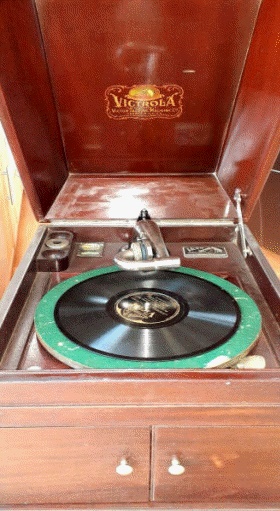 .
Sometimes the indicators are subtle. The machine on the left was
restored using the correct materials, but the shading is not correct. The
shade should be lighter toward the center of the middle doors, and slowly blend to
a darker color on the outside edges. Victor never stained these models with a
'banded' stain around the doors.
.
Sometimes the indicators are subtle. The machine on the left was
restored using the correct materials, but the shading is not correct. The
shade should be lighter toward the center of the middle doors, and slowly blend to
a darker color on the outside edges. Victor never stained these models with a
'banded' stain around the doors.
In some cases, owners may have
used a mild solvent such as naphtha to rub-down the rough original finish
and smooth it out without stripping it off. This process is sometimes
referred to as 'reamalgamation". This is also a form of restoration, and depending
on how well the job was executed, it can also be classified as an
"Incorrect Restoration".
In some cases, a
machine may have undergone work where the original finish has been removed
completely, as seen in the picture at lower right. This VV-90 is down to the
bare wood. This is also considered to be a restoration because the original
finish is gone. Upon careful inspection,
one can
also note that small elements of the dark original finish can still be seen in
the 'nooks and crannies" around the trim parts and doors. To be
returned to an acceptable state, this machine must
be stripped again, and properly refinished, which will be an expensive and
time-consuming process. Another tell-tale sign of a marginal restoration is
when the area around the "Victrola" decal is darker or of a different
shading than the surrounding area (below left). Someone stripped the finish,
but masked-off the area around the decal to preserve it. And they obviously
didn't match the original shade and glossiness when they applied the new
finish, and now the decal does not blend-in with the rest of
the lid.
 We have heard the
snarky comment from some hobbyists "Well, nobody can ever make the
machine appear as it did when it was new". That is not only an incorrect
statement, but is often used as an excuse to pawn-off a mediocre
restoration on an unsuspecting buyer. We have seen many outstanding
restorations that essentially return the machine to 'as-new' condition without
any excuses. The level of workmanship that can be attained by experienced
professionals is incredible. These are time-consuming and costly endeavors, but will assure
that the machine retains its value and collectability in the future.
We have heard the
snarky comment from some hobbyists "Well, nobody can ever make the
machine appear as it did when it was new". That is not only an incorrect
statement, but is often used as an excuse to pawn-off a mediocre
restoration on an unsuspecting buyer. We have seen many outstanding
restorations that essentially return the machine to 'as-new' condition without
any excuses. The level of workmanship that can be attained by experienced
professionals is incredible. These are time-consuming and costly endeavors, but will assure
that the machine retains its value and collectability in the future.
While most collectors
today avoid restoring
their phonographs where possible, in
some cases a high-quality restoration is
absolutely necessary. For a rare or unusual machine that is showing signs of
severe wear or damage, a restoration is often required to make the machine
presentable, and this is a quite acceptable decision for most of the collector
community. But that same rare machine can become severely depreciated if the restoration
is not done correctly.
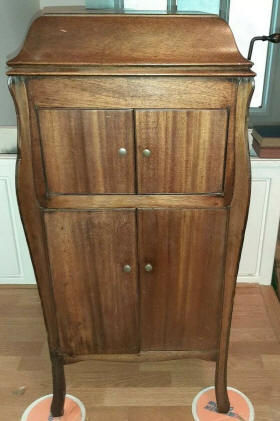
If an owner of any phonograph decides
that they prefer a nice glossy polyurethane finish, where authenticity is not a critical
concern, they certainly have the right to do
anything they wish with their
machine. Just be aware that an incorrect restoration of any type will
significantly diminish the grading and valuation. Poorly restored
phonographs are extremely common on the market, and make-up almost one-half
of the phonographs sold on Ebay and elsewhere. Clueless (or dishonest) sellers
will often misrepresent a restoration, with hopes of fooling the
buyer into believing that it is original, and thus securing a much higher price.
There are also phonographs which have been 'over-restored'; for
example where gold plating was used on parts that should be nickel,
where super-glossy nitro lacquer is used in place of varnish, or extra
embellishments are added, etc. These examples would also be considered as "incorrectly
restored".
An incorrect restoration will usually have the following
indicators:
-
As mentioned above, the presence of poor color matching between the internal areas (under the lid and inside the doors) and the exterior of the machine cabinet. If the "under-lid" shades are significantly different than the exterior cabinet color, that's a possible indicator of a restoration, although it is common for exterior portions of an original cabinet to have faded over time and due to exposure to heat or dampness. Many amateur restorers will simply strip and refinish the outside of the cabinet, and leave the interior portions alone if they are in good shape. But in this instance, the colors and glossiness of the inside and outside will rarely match. If the exterior has an original finish and has faded over time, other evidence of long-term exposure (such as dings and scratches) should also be present.
-
If you notice that that the area surrounding the decal is different in color or gloss than the rest of the machine, that is an indicator of a poor restortion.
-
The use of overly glossy, dull, or 'plastic-like' finish materials.
-
Failure to use grain fillers on mahogany or walnut machines, resulting in a 'craggy' look
-
Dust specs or blobs, especially in corners or crevices. It's somebody's basement refinish job, most likely a bad one. Those artifacts would never appear on a factory finish.
-
The presence of dings, scratches or gouges which are finished-over to which match the cabinet color. When the veneer on a phonograph is subjected to impacts or scratching, the resulting injury will often reveal the original (unstained) veneer color. For example, if you scratch a dark-red mahogany machine, the resulting "injury" will often appear off-white or brown due to the fact that the surface finish was removed. The application of furniture touch-up products can blend-in the correct color to some extent, but if you notice a lot of dings and zings all over the machine, most of which have been finished-over, then you are looking at a restored phonograph. Professional restorers will use filler products to repair damage and blend-in the color prior to applying finish coats.
-
Runs or drips. Victor's quality control was fantastic. We've seen a few originals with small runs from the factory that got past the Q/A inspector, but they are few and far between. If a machine has runs, splotches, or has an unevenly applied finish coat, it's a refinish job. Poor application of finish materials can also result in a slightly "wavy" appearance, as if the finish coats were not applied evenly. Check under the doors and motorboard. There will usually be some evidence of minor drips or discolorations at the bottom of doors, or inside/underneath the cabinet, even when a phonograph has been correctly restored.
C. GRADING A RESTORED MACHINE
There are only three '"condition grades" for restored machines:
-
A machine which has been restored to professional standards (closely replicating the original factory appearance) and is in excellent condition, showing no wear or very minimal usage. The finish must be near perfect, and all components retain the correct appearance. This is classified as RESTORED-EXCELLENT
-
A correctly restored machine which shows minor signs of wear due to age or usage. This is classified as RESTORED-GOOD
-
An incorrectly restored machine or a well-restored machine showing considerable wear or damage. This is classified as RESTORED-MARGINAL (no matter how nice it may appear).
The
VV-XIV, shown at the left, has been correctly restored using the proper
stain, shellac sealer and varnish top-coat, and would be considered to be
"RESTORED EXCELLENT". It very closely approaches the appearance it had when
new, and there is absolutely no damage. Note that the finish
color and sheen is the same throughout.
Why is there no
"RESTORED-FAIR" or "RESTORED-POOR" classification? Because the vast
majority of collectors (with the money to buy what they want) are looking
for exceptional and correct machines. A phonograph which underwent an
excellent and authentic restoration back in 1980, and has since been
knocked-around or subjected to damage will require re-restoring, just as
would be the case for a poorly restored phonograph. Therefore the valuation for a correctly
restored machine which is not in good condition would be comparable to
the value of a machine which has been incorrectly restored. They both
will require a complete 're-do'. So there is no need for additional categories
of restored phonographs.
Restored machines are thus graded by us as either "RESTORED
EXCELLENT", "RESTORED GOOD" or "RESTORED MARGINAL". No further evaluation is required.
D: GRADING AN ORIGINAL FINISH
If a machine is determined to have an original finish, we utilize 6 primary grading classifications for our appraisals. It should be noted that many appraisers will use a '+' or '-' symbol to indicate that the condition is slightly better or worse than the overall category indicates.
-
ORIGINAL-MINT: This category consists of less than 1% of the surviving population
-
ORIGINAL-EXCELLENT: This category consists of less than 5% of the surviving population
-
ORIGINAL-GOOD: This category consists of about 15% of the surviving population
-
ORIGINAL-FAIR: This category consists of about 25% of the surviving population
-
ORIGINAL-POOR: This category consists of about 35% of the surviving population
-
ORIGINAL-P/M (Parts Machine): This category consists of the remaining 20% of the surviving population. (Many phonographs which would have fallen into this category have already been junked over the years)
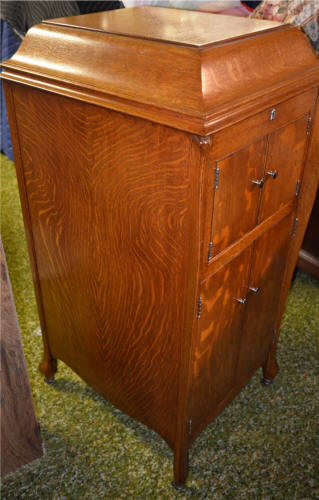 A. ORIGINAL-MINT
It is the extremely rare 100+ year-old
phonograph that appears in true mint condition ('as new'). We have certainly
seen some incredible mint original phonographs, and they can be worth a lot
of money. If the machine has a perfect and smooth finish, bright gleaming
hardware and absolutely no signs of wear or use, than the appraiser must be
on the lookout for signs of an extremely well-executed and correct
professional restoration. Some awesome originals are certainly
still around, such as this oak VV-XI (left) which brought very good money
for a common machine at a recent auction. It had been covered-over in
blankets inside a closet for most of its life. Flawless machines which fall
into this category are highly prized by collectors, but the appraiser must
carefully inspect the cabinet and hardware to assure that it is truly an
original finish. Mint condition means exactly what it implies. A flawless original
finish and hardware, perfect plated hardware components, the original
turntable felt, and the presence of the correct license sticker. If it shows any scratches, discoloration, corrosion, wear or
dings, then it is not an ORIGINAL-MINT rated machine. It has to be at least
99% flawless. Not many are out there.
A. ORIGINAL-MINT
It is the extremely rare 100+ year-old
phonograph that appears in true mint condition ('as new'). We have certainly
seen some incredible mint original phonographs, and they can be worth a lot
of money. If the machine has a perfect and smooth finish, bright gleaming
hardware and absolutely no signs of wear or use, than the appraiser must be
on the lookout for signs of an extremely well-executed and correct
professional restoration. Some awesome originals are certainly
still around, such as this oak VV-XI (left) which brought very good money
for a common machine at a recent auction. It had been covered-over in
blankets inside a closet for most of its life. Flawless machines which fall
into this category are highly prized by collectors, but the appraiser must
carefully inspect the cabinet and hardware to assure that it is truly an
original finish. Mint condition means exactly what it implies. A flawless original
finish and hardware, perfect plated hardware components, the original
turntable felt, and the presence of the correct license sticker. If it shows any scratches, discoloration, corrosion, wear or
dings, then it is not an ORIGINAL-MINT rated machine. It has to be at least
99% flawless. Not many are out there.
ORIGINAL-EXCELLENT
An "EXCELLENT" original-finish phonograph is
simply one-step below a "MINT" example. It must have very little evidence of
wear or use, and will appear to the novice as being a 'like-new' machine.
Most sellers and inexperienced collectors are far too generous in their use of
"EXCELLENT"; it must be reserved for those few machines which have been
exceptionally cared-for and show very little variation from a brand new
machine. The VV-XVI (picture at left) has a beautiful waxed
oak finish and shows virtually no wear. However, there are some minor age
discoloration marks above the top doors, and a few black 'spots" as can be
seen on the bottom doors. Even though it is a spectacular original example,
these blemishes will prevent it from being classified as "MINT". Serious
collectors pay attention to these details.
 ORIGINAL-GOOD
A phonograph classified as "Original Good" is a
very presentable and complete example, showing below-average wear and
usage. While there may be minor blemishes and mild crazing (surface
roughness due to aging of the varnish), these imperfections are not
sufficient to detract from the overall appearance. The example at left shows
a complete and correct machine, with very little evidence of exterior color
fade. The nickel-plated hardware is in good shape and
still has plenty of 'sparkle'. Some crazing can be seen on the doors, but
not to the extent where it appears to overwhelm the finish (which still
retains nice depth and some of its original gloss).
ORIGINAL-GOOD
A phonograph classified as "Original Good" is a
very presentable and complete example, showing below-average wear and
usage. While there may be minor blemishes and mild crazing (surface
roughness due to aging of the varnish), these imperfections are not
sufficient to detract from the overall appearance. The example at left shows
a complete and correct machine, with very little evidence of exterior color
fade. The nickel-plated hardware is in good shape and
still has plenty of 'sparkle'. Some crazing can be seen on the doors, but
not to the extent where it appears to overwhelm the finish (which still
retains nice depth and some of its original gloss).
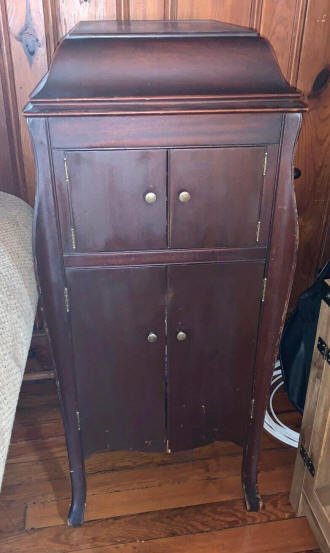 ORIGINAL-FAIR
A phonograph classified as "Original Fair" will
show signs of considerable wear and use, and may exhibit minor to moderate
damage. The finish will have dulled and/or faded, and the presence of
scratches and dings will be typically be found. There may be considerable
crazing (roughness) of the varnish due to long-term exposure to heat or
dampness. Interior surfaces should still retain good color and a smooth original finish. The hardware may also show moderate wear, and the original plating may have
worn-off in places. Small (non-critical) parts may be missing.
Phonographs in this condition are commonly found today.
ORIGINAL-FAIR
A phonograph classified as "Original Fair" will
show signs of considerable wear and use, and may exhibit minor to moderate
damage. The finish will have dulled and/or faded, and the presence of
scratches and dings will be typically be found. There may be considerable
crazing (roughness) of the varnish due to long-term exposure to heat or
dampness. Interior surfaces should still retain good color and a smooth original finish. The hardware may also show moderate wear, and the original plating may have
worn-off in places. Small (non-critical) parts may be missing.
Phonographs in this condition are commonly found today.
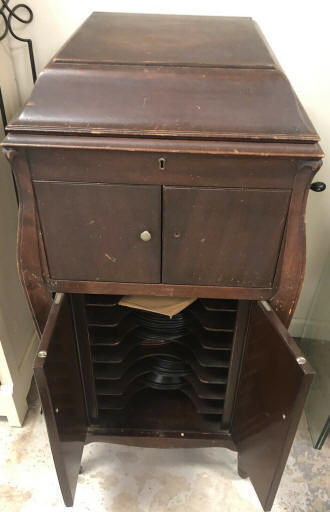 ORIGINAL-POOR
A phonograph
classified as "Original Poor" will typically show significant damage
or wear to the
cabinet, fading and/or severe crazing of the varnish finish.
The exterior surfaces will have little or no 'shine' remaining. The
machine may be missing some important parts, and plating on the hardware may be
corroded or worn-through. Machines in this condition are also commonly found
on the auction and sale circuit today.
ORIGINAL-POOR
A phonograph
classified as "Original Poor" will typically show significant damage
or wear to the
cabinet, fading and/or severe crazing of the varnish finish.
The exterior surfaces will have little or no 'shine' remaining. The
machine may be missing some important parts, and plating on the hardware may be
corroded or worn-through. Machines in this condition are also commonly found
on the auction and sale circuit today.
 ORIGINAL-
P/M (PARTS MACHINE)
A phonograph
in this classification has deteriorated
beyond practical repair or restoration, and will usually be used as a parts donor. This
may include machines which have been cut-down, are missing major cabinet
parts, or have had long-term exposure to the elements. Machines with missing
veneer (left) and/or serious water damage would also fall into this
category. Of course, a machine in POOR condition certainly can be restored,
but unless the phonograph is rare, it is usually not worth the cost of
effort.
ORIGINAL-
P/M (PARTS MACHINE)
A phonograph
in this classification has deteriorated
beyond practical repair or restoration, and will usually be used as a parts donor. This
may include machines which have been cut-down, are missing major cabinet
parts, or have had long-term exposure to the elements. Machines with missing
veneer (left) and/or serious water damage would also fall into this
category. Of course, a machine in POOR condition certainly can be restored,
but unless the phonograph is rare, it is usually not worth the cost of
effort.
P
PART TWO: Determining Market
Value
Once the phonograph has been graded for
'correctness' and 'condition', then the appraiser must undertake the
process of making a judgment of market value. As in real estate, the
best method to make this determination is via 'comparative analysis', or
simply reviewing summarized data on completed sales of similar machines
and determining where the appraised machine
should be valued. Gathering this information is a challenging
process, but most appraisers will review results from auctions, Ebay, estate
sales, etc. to use as a basis for establishing a machine's worth.
The only true
metric for valuation can be established via comparison with historical sales data. In special cases for extremely rare
models, the appraiser may need to contact other experienced collectors
and interpolate the available data to determine a realistic pricing.
Those few 'one-off' machines that are exceptionally rare may have no
comparable sales information available.
Appraised prices are often far lower than
many owners expect,
due to several factors:
-
The owner has over-graded the phonograph (e.g. considers it to be 'EXCELLENT' when it is actually 'FAIR") Determining the true condition is one of the most critical factors when appraising a phonograph.
-
The owner has seen a listing on Ebay where an identical machine is being offered for $2,000.00. If it didn't actually SELL for $2,000.00, then it probably isn't worth $2,000.00
-
The owner has watched a TV show where 'some old phonograph' was valued at thousands of dollars. The rarity and collectability of the particular model being appraised and its true condition determines value. There is no 'broad relative valuation' across all the different types and models of phonographs produced. Many models had production outputs of well over 1/2 million units, and tens of thousands of them are still around today. Just like "Wheat Pennies"; there are a zillion of them still in circulation, but only a tiny fraction will bring a high price.
-
The owner is basing their valuation based on 1990's prices. The collector's market has seen prices decrease significantly over the past 20 years. Many models have fallen 50% or more in value since that time
-
The owner assumes that 'the machine I restored in my basement last year' will be worth as much as an excellent original example. That situation is never true.
-
The oft-heard presumption that "if it is old, it must be worth some money". Another inaccurate statement.
-
The owner is 'emotionally attached' to the phonograph, or has spent a great deal of time repairing and restoring it. Unfortunately, the knowledgeable buyer will not take any of this into consideration when purchasing a phonograph.
The statement we make in every appraisal is as follows:
"Current Fair Market Value is the statistical mean of realized transaction prices for comparable examples, based on a significant sample population of buyers and sellers in the recent past, neither being required to act, and both having reasonable knowledge of the facts"
That statement says it all.
The categorization basis for the Current Market Value will ultimately be based upon four key factors:
-
Rarity. How many were originally made? How many have survived?
-
Completeness. Is it all there? Are parts missing?
-
Originality. Has it been restored? if so, how authentic is the restoration?
-
Condition. As they say, 'condition is everything'
-
Special Considerations. Does the phonograph have especially attractive wood figuring? Are the original purchase documents still with it?
Rarity is certainly an important
consideration in determining value, but there are many machines that
were originally produced in low numbers and won't bring much money in
today's market. A good example is the Victrola VV-107.
Only 1,007 of these phonographs were produced, making it amongst the
rarest of all upright models. However, collectors simply don't have much
interest in it, as it is not particularly attractive, nor does it have
any exceptional design features that make it stand-out from other
models. Prices for 107's were quite high in the 1990's, but demand has
since plummeted, and good examples can now be found for around $600.00
or so at auction. Rarity does not always relate proportionally to value.
There are early machines, such as the Victor D
which were made in relatively high numbers, but demand remains high.
They have a very impressive appearance and most collectors will pay well for a nice example. Victrolas with
rare or unusual finishes will always bring more money than those in
mahogany or Golden Oak, which were the most commonly produced products.
For example, a VV-XVI with an "Excellent Original" Driftwood Oak finish
can be expected to sell for at least twice as much as the same model in
a mahogany finish. The type of finish can be an important consideration
in determining value.
It must be stated again that,
in the vast majority of instances, a phonograph which has been restored
will be worth less than an identical phonograph which retains its
original finish, even if the original finish shows signs of wear.
If a machine has undergone a correct and authentic restoration
which uses original materials and the appropriate restoration processes,
its collector value can be maintained to a reasonable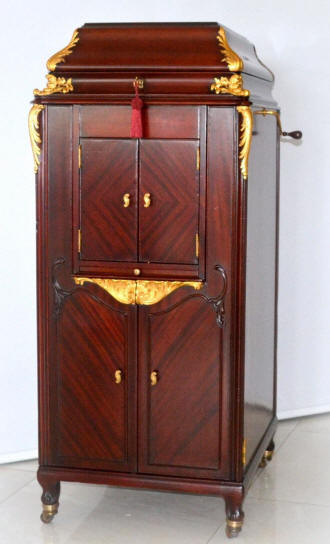 extent. The antique phonograph hobby is not like the car collector
hobby, where a well-restored 1928 Packard will likely bring more money
than an original example which needs some work. The marketplace for antique furniture
is very different.
extent. The antique phonograph hobby is not like the car collector
hobby, where a well-restored 1928 Packard will likely bring more money
than an original example which needs some work. The marketplace for antique furniture
is very different.
If, for example, one finds a extremely rare VV-XX model
in "Good Original" condition, and another identical machine which has
undergone an excellent and correct professional restoration (as seen at
left), the value of both machines might be considered about equal from a
collector's standpoint. But the same model, which is rated to be an
"Excellent Original" condition, will most certainly bring more money
than any machine which has been restored to any level of perfection.
Collectors simply prefer an original finish, and are willing
to pay for it. Now, if we find the same rare VV-XX that
has undergone an amateur or incorrect restoration, then its market value
is likely to be far less than an original machine in virtually any
condition. Why? Because the serious collector who can afford to purchase
such an expensive machine will certainly not want to display it with an
incorrect appearance. So the machine will have to be re-restored
(correctly), which can be expected to cost many thousands of dollars. So
that factor must be considered when appraising the phonograph; the
presence of an incorrect restoration must be taken into account, and the
value will consequently suffer.
Now take the case of a common
phonograph, such as a VV-XI. Over 850,000 copies of
this model were made, and they are still found at almost every auction
and swap-meet. The appraised value of an example in typical "Fair"
condition runs about $125.00 in the current market. An example in
absolutely mint original condition might, on a good day, bring
upwards of $500.00. So it makes no sense for a collector to purchase a
VV-XI with an amateur restoration priced at $300.00. If he were to buy
it for display in a serious collection, the machine would require a
complete re-do of the restoration, which would cost a lot of money. Why
not just wait for an excellent original which might be had for a smaller
overall investment? Most phonographs which have been incorrectly
restored will become someone's hobby project or a parts-donor; consequently, the appraised value will be
severely reduced. Rare models are often worth re-restoring, but
again, if they have an non-authentic restoration, the appraisal will
reflect the necessary cost to return it to an authentic state. A VV-XI
with an typical amateur restoration might bring $75.00 at auction on a
good day.
Many readers may have found an empty Victrola cabinet.
The 'innards' may have been removed years ago. Spring-wound motors were
often used as fishing trawls. During World War Two, "Scrap Metal
Drives" were commonly promoted, wherein unused steel and metal items
were turned-in for melt-down to help the war effort. Many Victors and Victrolas
were stripped-out for this purpose. Unfortunately, empty cabinets will
not bring much (if any) money today. They may be of interest to someone
rebuilding a machine, but in most cases, they are simply converted into
liquor cabinets or display stands which almost never sell. Trying to
match an empty cabinet to a buyer is an extraordinarily difficult task,
and will rarely result in any significant valuation unless the cabinet
is from a very rare model
To get an idea of the true market price vs. what most
sellers unrealistically expect to yield from the sale of their machines,
the reader is encouraged to log into Ebay and run a search on "Victrola
XI". Again, this was the most popular model Victor made, and tens of
thousands of them are still around. You will likely find listings with
starting prices ranging from $50.00 to over $1,000.00. Some will be very
nice originals, others have been incorrectly restored. Some will have
been stripped down to bare wood, while a few may have been converted
into fish tanks or curio cabinets. However, none of these individual listings will
provide the reader with valid information on the actual value
of a Victrola XI with a "GOOD" original finish. Based on analysis we did
back in 2017-2018, the average Ebay starting price for an XI
was a whopping $405.89. This was presumably what the average seller
presumes their machine is worth. Of the 243 Ebay XI listings we
'audited' during that time, less than 5% of the machines actually
sold at any price, and those that did sell averaged at a closing
price of $114.36. That's about the correct average market value for a
large population of XI machines in vastly different conditions. However,
the highest single sale price during that period was $245.50,
meaning that the nicest XI that actually sold during that
timeframe brought a price which was almost 72% less than most sellers had
hoped to achieve! This indicates that seller expectations for this model are
greatly inflated; it also reflects what actual buyers are willing to pay
for a common model like the XI. Looking at the mean (average) of
completed sales is the only way to begin the process of determining a
true market value.
There are thousands of retail sources
for phonographs; these include antique stores, thrift shops, flea
markets, swap meets, etc. As with Ebay, asking prices will be all over
the map, and will mean absolutely nothing in determining the worth of
your phonograph. Machines will often sit unsold for months and years,
and the few that do sell may be purchased by unwitting shoppers who have
no clue about what they are buying and the true market worth. In
addition, most sellers are equally clueless about antique phonographs;
they have no idea if their machines are original and correct than does
the poor uniformed shopper who may pay a 300% retail-store price premium
for a common Victrola that catches their fancy. Unless you own a retail
store (and are VERY patient in moving inventory), don't expect to come
anywhere close to realizing typical retail 'asking' prices. And most
machines never sell at the posted prices.
There are reliable antique phonograph dealers across the country who
specialize in phonographs, who will guarantee authenticity, and who will
provide the buyer with a good warranty; consequently, their prices will
be significantly higher than will be found for machines being sold
'as-is' at auctions and estate sales. These specialized retail
operations must locate and purchase high-quality examples, perform
clean-up and needed repairs, and give the buyer a good warranty; don't
expect to realize those prices when you sell your phonograph on
Ebay.
Of course, rare and valuable machines do turn-up in surprising
places. Collectors and 'pickers' have found many exceptional phonographs
in junk stores or yard sales
over the years, some worth well in excess of $10,000.00. But they are
very few and far between.
Running queries on online auction sales is
a good way to get a handle on the true market value of your phonograph.
Ebay, Proxibid and other online auctions can yield a great deal of
information on what collectors are actually paying for machines today.
Just make sure that you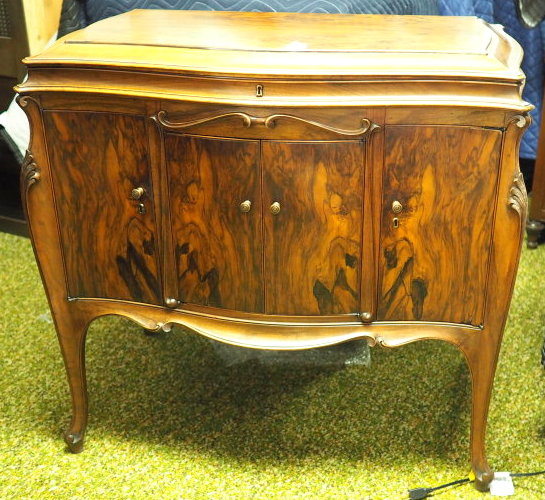 are comparing 'apples-to-apples' in your search. You can
only compare identical models in similar condition to establish a true
valuation of your phonograph. If your machine is
"RESTORED-MARGINAL", than don't compare it against "GOOD-ORIGINAL" sales
data. And only consider those phonographs that have actually sold.
Asking prices mean absolutely nothing.
are comparing 'apples-to-apples' in your search. You can
only compare identical models in similar condition to establish a true
valuation of your phonograph. If your machine is
"RESTORED-MARGINAL", than don't compare it against "GOOD-ORIGINAL" sales
data. And only consider those phonographs that have actually sold.
Asking prices mean absolutely nothing.
Evaluating
the value of machines with 'special considerations' becomes a subjective factor. However, any phonograph which has
exceptional grain figuring, original paperwork, special-order finishes
or similar enhancements will certainly be of added interest to
collectors. For example, a VV-230 in a spectacularly figured Circassian
Walnut finish (picture at right) would be expected to bring more money
than a similar Circassian example with a subtle grain
figuring. Collectors love unusual and striking phonographs. In these
cases, an experienced appraiser will usually know the amount of added
value that these types of considerations will bring in the market.
We
maintain a large statistical database of realized sale prices and
summaries of surviving examples of all Victor phonograph models, which
is used in our appraisal services. For those interested in having a
formal appraisal completed for their Victor phonograph, please click
here.

